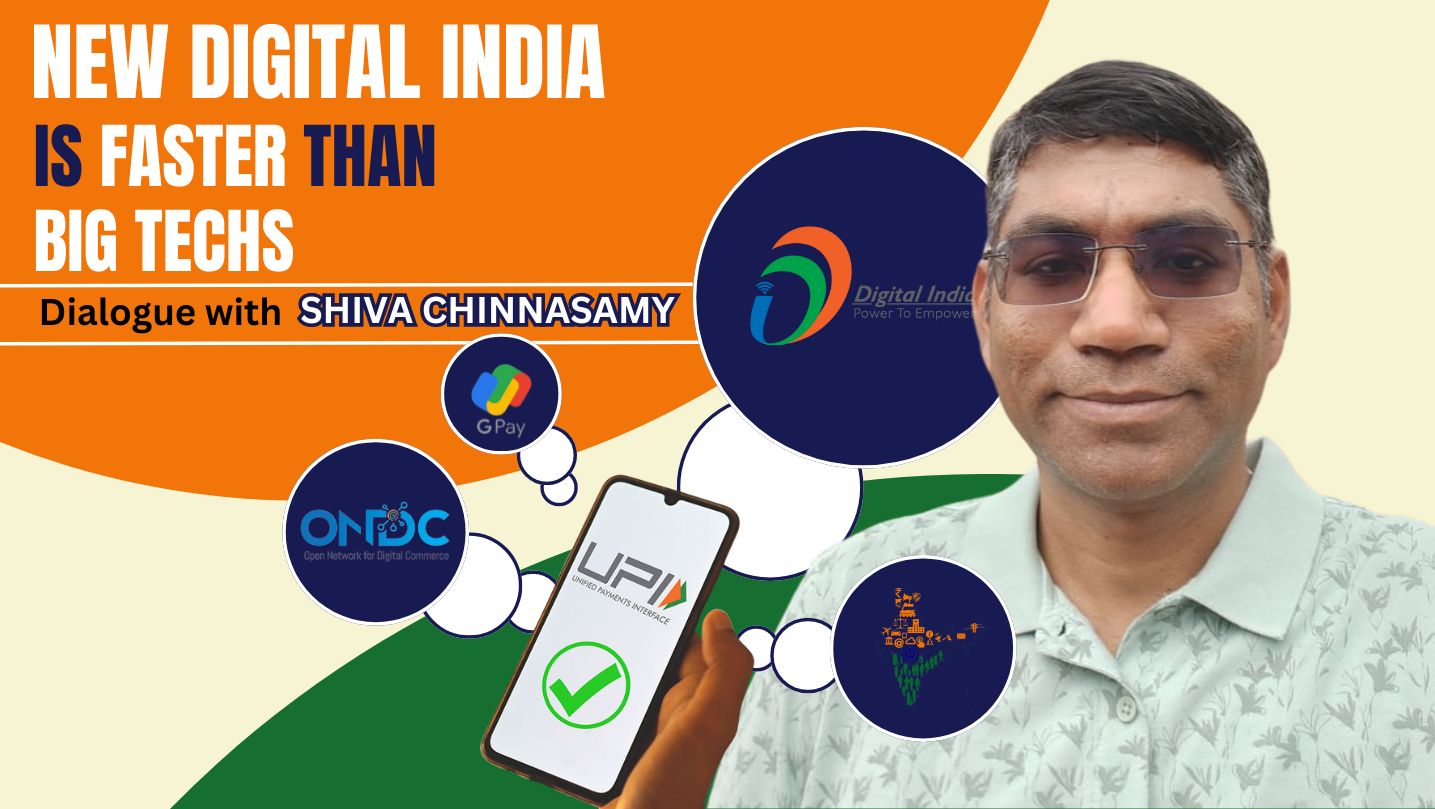
While the Digital India initiative has demonstrably simplified digital transactions even in remote villages, its true potential is far more ambitious. The Indian government's vision for the future digital ecosystem is nothing short of breathtaking. He emphasises that we've only begun to tap into this potential, with less than 10% of it realised so far, says the visionary Shiva Chinnasamy, a Bangalore-based tech leader and a former Engineering Director of Google Pay.
Shiva Chinnasamy's eyes sparkled with pride as he recounted his roots in Karur, Tamil Nadu, where he spent his formative years attending a Tamil-medium school. His thirst for knowledge led him on a remarkable educational journey from Chennai to Purdue University, Indianapolis, where he studied MS in computer science. Today, he stands as a seasoned and dynamic technology executive, showcasing remarkable business acumen and boasting extensive global leadership experience across various domains and tech platforms, including AdTech, eCommerce, omnichannel retail, B2C FinTech, B2B SaaS, platform engineering, and mobile engineering. Notably, he played a pivotal role in shaping the landscape of digital payments in India through his contributions to the development of UPI (Unified Payments Interface) technology. During our conversation, he generously shared invaluable insights into India's digitalisation journey, discussing the inception of UPI, the potential of Aadhaar, DigiLocker, ONDC (Open Network for Digital Commerce), digital currency, and much more.
The idea of digital public infrastructure for the nation traces back to a non-profit organisation called iSPIRT, founded and staffed by volunteers from the tech world. Initially driven by passionate individuals, this movement gained significant momentum when the Government of India adopted it as a free and open standard initiative. This transformative decision turned it into a national movement, extending its reach even to the remotest corners of villages, fostering a level playing field and preventing monopolies. Previously, digital payments were largely controlled by a few private organisations, limiting transactions to internal networks. However, the government's strategic initiative aimed to democratise access to this technology nationwide. This pivotal shift has fundamentally altered India's digital landscape, elevating its standards on a global scale.
The Modi government has long championed the concept of digital public infrastructure. When Nandan Nilekani first proposed the idea of UPI, Shri Narendra Modi grasped its potential and the myriad possibilities it presented. UPI technology represents just a fraction of the comprehensive vision encapsulated by Digital India. While developed countries like the US continue to rely on paper checks, India has surged ahead, enabling entirely digital transactions. This forward-thinking approach underscores India's leadership in embracing digital innovation and signifies a paradigm shift in the global digital landscape.
This visionary approach traces back to the inception of Aadhaar, a unique identification system that laid the foundation for a multifaceted digital ecosystem. The integration of Aadhaar with mobile numbers marked a significant step forward. The government further bolstered this initiative by encouraging banks and the public to establish zero-balance savings accounts through the Pradhan Mantri Jan-Dhan Yojana (PMJDY). Subsequently, a robust security layer was introduced, implementing two-factor authentication with biometrics and OTP (One Time Password). With identity, banking, and authentication layers in place, the focus shifted to streamlining documentation through DigiLocker. This innovative platform eliminated the need for physical documents such as driving licenses, Aadhaar cards, ration cards, and educational certificates. Educational institutes can now issue electronic certificates directly to users' DigiLockers, accessible through mobile authentication.
This digital shift has significantly reduced corruption by enhancing transparency and accountability. Digital documents have gained widespread acceptance, and it's foreseeable that they will eventually become the sole accepted form of documentation. Incorporating the UPI payment layer into this ecosystem is the cherry on top, simplifying bill payments for utilities, insurance, property taxes, and more. This holistic ecosystem has propelled the nation into a digital era, marking a significant milestone in India's technological evolution.
But that’s not the end…
Businesses are also among the primary beneficiaries of this ecosystem. Through the registration for a merchant account and streamlined tracking of transactions, businesses can easily categorise their activities, facilitating a smoother taxation process. Micro, Small & Medium Enterprises (MSMEs) have mainly reaped the benefits of this digital landscape. Even small-scale vendors, such as vegetable sellers, have embraced innovation by introducing audio systems that provide transaction details courtesy of private organisations like GPay and PhonePe. These private entities recognise the immense potential of the system to drive innovation and create new business opportunities. “In fact, it's noteworthy that even big tech companies are finding it challenging to keep pace with the government's rapid strides in digitalisation. The people of India have exhibited remarkable openness and adaptability to these changes, far surpassing many foreign countries in their embrace of digital transformation”, says our tech guru.
He was delighted to share another compelling analogy he had encountered. "Traditionally, fishermen would only conduct business upon returning to shore after a catch. However, with the advent of the digital ecosystem, fishermen now engage in transactions directly from the waters using social media groups, collect payments through UPI, and deliver the fish directly to buyers on the shore. This allows them to embark on multiple trips into the ocean within the same day, significantly boosting their revenue." This transformative shift embodies the essence of the new India, offering hope that anyone willing to exert themselves can achieve success. The concentration of wealth within a select few is no longer the norm.
"In the future, lending loans will become simpler," he predicted. "With the digital recording of individuals' credit history, which can be accessed, shared, or collateralized at any point digitally, loan approvals will be streamlined. This development will significantly benefit businesses as well. Furthermore, it is likely to diminish the necessity for credit cards in the future, as transaction charges tend to be higher and monopolized by a few giants in the market."
The Department for Promotion of Industry and Internal Trade of the Government of India has taken a significant step by establishing a private non-profit Section 8 company called the Open Network for Digital Commerce (ONDC). This initiative aims to foster open e-commerce, eliminate monopolies within the marketplace and provide businesses with free and easy access. Through ONDC, sellers can directly list their products for sale digitally without incurring charges from platforms such as Amazon and Flipkart. Consequently, this move will drive down buyer product prices, enhancing affordability and accessibility.
The next initiative on the government's horizon is the OCEN - Open Credit Enablement Network. The pressing challenge ahead is to facilitate more accessible access to capital. OCEN aims to address this challenge by enabling businesses to access credit more readily, allowing small-scale vendors to obtain everyday credit for smooth operations, and promoting buy-now-pay-later systems. "I must commend the government for maintaining a level playing field to prevent exploitation," he remarked. This initiative will empower users to secure low-interest loans while failures are mitigated through the transparency of credit records.
But that’s not all…
The one that is waiting in line for India is Digital currency. One challenge with the UPI is that it differs from the actual money we are dealing with. It is only a mechanism that deals with the real currency through banks. However, with digital currency, the currency is actually with the user. The user has absolute freedom with his money. It is more similar to cryptocurrency; the only difference is that it is centralised. Also, with digital currency, the existence of black money becomes nil.
On top of that, digital currency is programmable. The currency can be programmed to do a particular task, making taxation easier. “Imagine a situation where the money that I send automatically programs to split in share and taxes are being done on the spot. The money that are spent on health care or philanthrophy can be programmed to be non-taxable. This is only an example, but the potential is much larger”, says Shiva Chinnasamy.
Other countries are showing keen interest in UPI, and India is equally interested in establishing UPI as a global system. It's a mutual discourse," he emphasised. "We have an incentive to make UPI the global payment interoperable network. This benefits our own tourists when they travel abroad, as they won't necessarily need credit cards and incur fees charged by entities like Visa. With our population of 1.4 billion and the increasing prosperity of our people, we anticipate becoming the largest source of tourists in the coming years. So, UPI becoming a global system is advantageous in both ways.”
Shiva Chinnasamy further emphasised the importance of the youth in India taking a keen interest in technology, as it represents the future. “Indians are inherently adaptable, and our learning networks are robust. Even in areas that may be economically disadvantaged, there are individuals with education who facilitate digital payments for everyone in the community," he observed. "It's essential for the youth to shoulder financial responsibilities, utilize credit effectively, and exercise control over their spending habits. Only then can our nation truly emerge as an intelligent and economically empowered country."
In conclusion, the enlightening conversation with Mr. Shiva Chinnasamy has instilled in us a vision of a thriving new India under the adept leadership of Prime Minister Shri Narendra Modi. As our External Affairs Minister, Shri S. Jayashankar, aptly asserts, "India is on its way to becoming a global leader." Digital India stands as a testament to this vision, silently but powerfully conveying the message that we can aspire to greater heights than ever before, for the possibilities are indeed within reach.
|| Bharat Mata ki Jai ||
|| Satyamev Jayate ||

NEXT ARTICLE

"A staggering one in five children in India is pre-diabetic," revealed Mrs. Swathy Rohit, the visionary founder of Coimbatore-based digital health p...

Where a rhythmic cadence of music blends seamlessly with the structured world of auditing, we found Mukund Swaminathan, a 26-year-old maestro who has...

"Life doesn't offer retirement, only professions do. While I've stepped away from my practice, I haven't retired from living. No one truly retires whi...